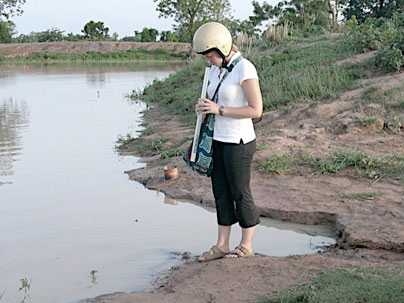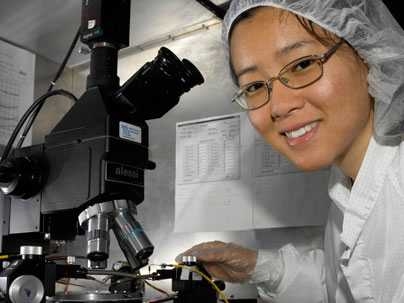Whether it was public service in South Dakota, an internship in Israel or Lincoln Laboratory, MIT students didn't just lounge around after classes ended last spring. Here's a sampling of what some MIT students did over the last three months.

Cambodia
Junior Shirin Kasturia spent six weeks this summer in Cambodia working with AFESIP, an organization that provides shelter, protection, basic education and vocational training for women and children who have been rescued from human trafficking for sexual exploitation, have willingly left prostitution, or are at high risk of being sold or trafficked. Kasturia's project involved shipping eight donated computers to use in AFESIP's three shelters in Phnom Penh, Siem Reap and Kampong Cham province in Cambodia.
While there, Kasturia set up the computers and taught the girls basic computer skills such as typing (in both Khmer and English) and using educational software so that they could teach their peers what they had learned
Ghana
Kate Clopeck, a graduate student in the Engineering Systems Division, spent her summer in Ghana, working on bringing fresh water to the masses through two different projects sponsored by MIT's Public Service Center.
For the first project, Clopeck worked with Vanessa Green MEng '08 to implement a community water-treatment system in Kasaligu, a rural village in Northern Ghana. "We distributed safe storage containers to the 200 households in the villages and then trained two local women to clean enough water for the entire village," Clopeck said. "These women then sold the clean water to the other members of their community for 5 peswas (about 5 cents) for each 20-liter safe-storage container."
The women earn enough money to maintain the water-treatment system and earn a small income. Currently, the system is still running and the MIT students continue to advise the team leadership and monitor the project's success.
Clopeck's second project was the evaluation of Pure Home Water, a small nonprofit that sells ceramic water filters in northern Ghana. She surveyed 221 of Pure Home Water's customers to determine if they were still using the water filter, and if not, why they had stopped. She plans to publish her findings in her master's thesis.
More images of Clopeck's work can be seen at picasaweb.google.com/kate.clopeck.
Israel
Ammar Ammar, a senior in electrical engineering and computer science, spent his summer working on YouTube at Google Tel Aviv in Israel as a part of MIT-Israel, the newest MISTI program.
Having lived most of his life in the region, Ammar was aware of the reputation of the Israeli technology sector and wanted to learn more about Israeli culture, politics and society.
The MIT-Israel Program carefully matches MIT students with internship opportunities in Israel, so for Ammar, who likes to design and build software systems and enjoys traveling and seeing new places, the Google internship was perfect. While there, he learned a lot about Google infrastructure, had the unique opportunity to advance professionally, meet Israelis and tour the country.
"The MISTI preparation gave me a strong background to understand the Israeli society and help me be successful in my internship. They really worked with me to find an internship that would be a right fit."
Lexington
Some students traded sunglasses for safety glasses as they participated in internships at Lincoln Laboratory, which offered summer programs for students from across the nation. The laboratory routinely hires summer students through the MIT VI-A MEng Thesis Program and MIT's graduate and undergraduate research programs.
This summer, more than 100 interns performed hands-on engineering at Lincoln Laboratory while addressing problems critical to national security.
The VI-A Program supports students doing their master's of engineering thesis, while UROP, UPOP and SURP enable undergraduates to investigate majors while conducting research, and SRP helps graduate students gain career skills.
Pei-Lan Hsu, doing her thesis research in the Advanced Silicon Technology Group, has worked at Lincoln Laboratory for the past three summers through the VI-A Program. "This internship is an eye-opener," says Hsu, "I'm learning how to be an engineer that gets things done -- knowing when to be exact, and when to approximate... I've also realized how much I still have to learn."
Michael Scarito, a UROP EECS/Physics student in the Advanced Networks and Applications Group, says "I'm increasing my understanding every time I use theories from courses and put them into practice in a lab."
Internships bring about an understanding of a field. "Sometimes students have a good intern experience, but decide it's not what they want to do; this is as useful as the internship that furthers you in your chosen field" says Gary Hackett, Lincoln Laboratory's College Recruiting Program Coordinator.
Often, the internship develops into post-graduation employment. Hackett says, "Internships are mutually beneficial -- they can view us as a potential employer, and we can view them as a potential employee," says Hackett. Through these programs, students contribute critical thinking in real time, in real life, while complementing their course of study.
South Dakota
Allison Brown '08 and Kendra Johnson '09 worked for the Environmental Protection Program of the Oglala Sioux Tribe on Pine Ridge Reservation in South Dakota. The tribal government faces a tremendous challenge in maintaining infrastructure and providing services to 26,000 inhabitants of the reservation, which is larger in area than the states of Delaware and Rhode Island combined and contains some of the poorest counties in the country.
Johnson and Brown worked to develop the capacity of Oglala Lakota College, the tribe's community college, to process water quality samples for the tribe. In addition, Allison collaborated with Stephan Schweig, a mechanical engineering student from Germany, to assist the tribe's efforts to develop renewable energy capacity on the reservation. Kendra worked together with the Environmental Protection Program staff to begin developing a watershed management plan for two small grassland streams: Wounded Knee Creek and Porcupine Creek. They are in the process of setting up a project for next year's interns to help a community build its own wind turbine from old car parts, scrap metal and other common, inexpensive materials.
More information is available on Johnson's blog.
And the MIT Public Service Center is looking for MIT students interested in going to Pine Ridge during IAP to work with the college lab on state certification for water quality analysis, or on other projects. Interested students can find out more at the public service center's web site at web.mit.edu/mitpsc.
A version of this article appeared in MIT Tech Talk on September 10, 2008 (download PDF).








